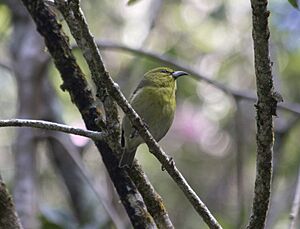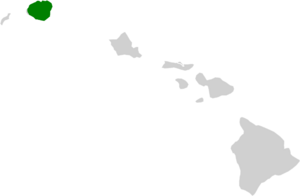Kauaʻi ʻamakihi facts for kids
Quick facts for kids Kauaʻi ʻamakihi |
|
|---|---|
 |
|
| Kauaʻi ʻamakihi Chlorodrepanis stejnegeri |
|
| Conservation status | |
| Scientific classification | |
| Genus: |
Chlorodrepanis
|
| Species: |
stejnegeri
|
 |
|
| Synonyms | |
|
Viridonia stejnegeri Wilson, 1980 |
|
The Kauaʻi ʻamakihi (Chlorodrepanis stejnegeri) is a special type of Hawaiian honeycreeper bird. It lives only on the island of Kauaʻi in Hawaii. This bird belongs to the finch family, called Fringillidae.
Its Hawaiian name, ʻamakihi, is linked to the word "kihikihi," which means "curved." This refers to the bird's unique curved beak. The Kauaʻi ʻamakihi looks a bit like the Kauaʻi nukupuʻu, which is now extinct. When it flies or eats, you can hear its special tweet.
Where the Kauaʻi ʻAmakihi Lives
This bird is endemic to the island of Kauaʻi. This means it naturally lives nowhere else in the world. The Kauaʻi ʻamakihi usually lives in the higher parts of the Kauaʻi mountains. You can often find them above 600 meters (about 2,000 feet) in elevation.
They used to live in lower areas too. However, because their homes were lost, they now mostly stay in the mountains. These birds like to be near ‘ōhi‘a and koa trees. They are especially common in ‘ōhi‘a forests, where they often build their nests. You might spot them in places like Waimea Canyon, Nā Pali Plateau, Alaka‘i Swamp, and the Makaleha Mountains.
What the Kauaʻi ʻAmakihi Looks Like
The Kauaʻi ʻamakihi has a greenish-yellow body. It has black markings around its eyes, called lores. Its beak is large, shaped like a sickle, and curves downwards.
Male Kauaʻi ʻamakihi birds usually have bigger beaks and brighter colors. Female birds have smaller beaks and their feathers are a bit duller. These differences in feather color and beak size help tell the Kauaʻi ʻamakihi apart from other ʻamakihi species.
Protecting the Kauaʻi ʻAmakihi
The Kauaʻi ʻamakihi is listed as "vulnerable" by BirdLife International. This means it faces threats and could become endangered if things don't improve. While their numbers have stayed fairly steady, they still face dangers.
Like other Hawaiian honeycreepers, the Kauaʻi ʻamakihi is threatened by the loss of its natural home. They are also affected by invasive species, which are plants or animals that don't belong there. Another threat is avian malaria, a disease that affects birds. However, the Kauaʻi ʻamakihi has not been as badly affected by these problems as some other honeycreeper species.


